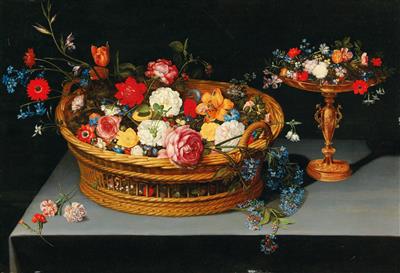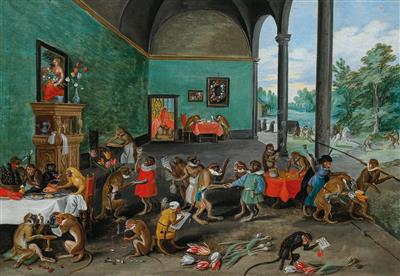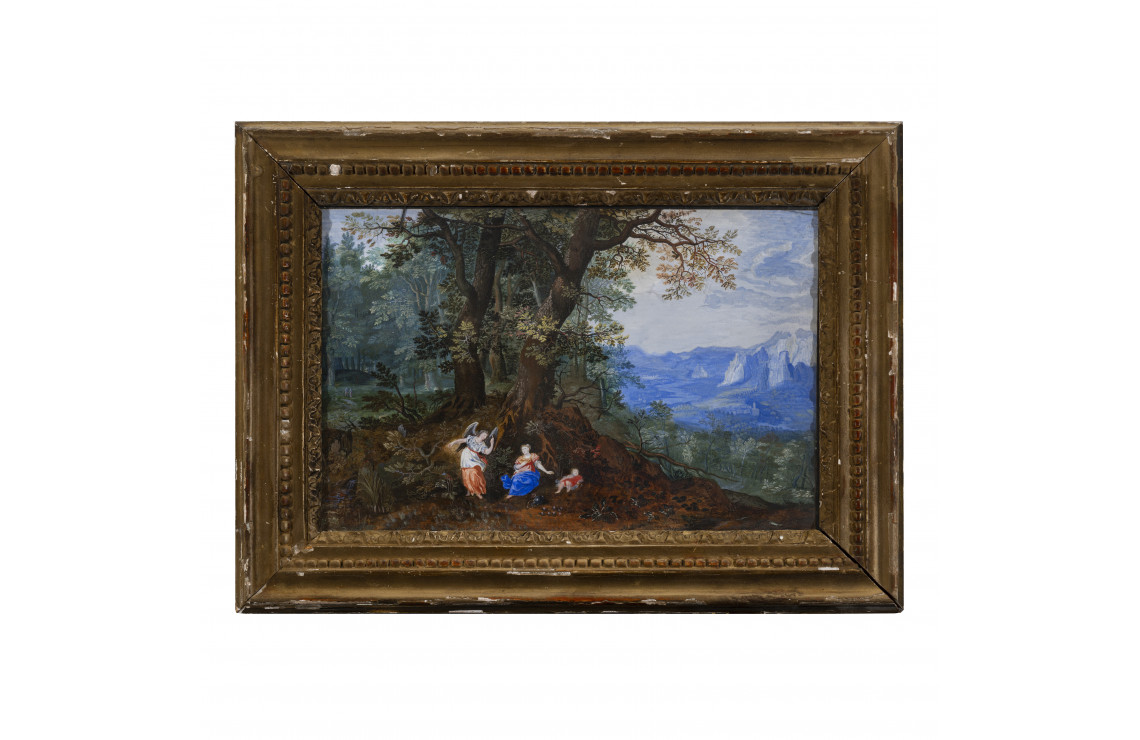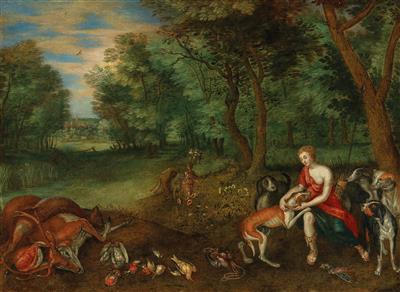(Antwerp 1601–1678) and Jan van Balen (Antwerp 1611–1654) The Holy Family with the Infant Saint John, oil on panel, 123 x 94.6 cm, framed We are grateful to Klaus Ertz for confirming the attribution of the present painting to Jan Brueghel II. A written certificate (July 2020) is available. Klaus Ertz writes: ‘The present painting can be said to have survived in excellent condition. The brilliant colours are applied in thick impasto and make a very good impression, as do the white highlights applied in a final step, lending the voluminous garland of fruit its three-dimensionality […]. The viewer perceives the tree-clustered park landscape opening up towards the background from a slightly raised vantage point. The foreground of the composition is dominated by a garland of fruit extending along the left and right margins, in front of the landscape space. The garland seems to be held at the top by the branches of several trees in the foreground, and supported on its lateral strands, closing in towards the bottom of the composition. Tracing the basic outlines of the capital initial “M” (an allusion to Mary) while indulging in unparalleled diversity, the painter has arranged fruit, flowers, vegetables, salads, and grains around a group of figures depicted in the foreground of the composition, on the ground of a clearing. From left to right, this group consists of two winged angels –the one on the left shown in the nude, the companion to his right scantily covered by a bright red cloth; they are followed by the Infant John the Baptist, clad in a light-brown cloth as an allusion to the familiar fur garment and presenting a bunch of grapes to the naked Christ Child, who reclines on a white cloth in the lap of his mother, the Virgin Mary. The two boys face each other. Mary has lowered her gaze to observe the presentation of the gift. She wears the traditional red dress and blue cloak, her head encircled by a thin mandorla and covered with a scarf. Behind Mary appears the seated figure of Elizabeth, John the Baptist’s mother. Closing the group of figures vertically, she reads in an open book, an allusion to the New Testament […]. The fecundity of nature obviously also encompasses the animal kingdom: within the garland, we can find various indigenous birds, as well as exotic examples like parrots and parakeets. At the foot of the garland appear, from left to right: a feeding monkey, two white rabbits, a monkey dressed in a yellow and red costume, two guinea pigs, and a dark-faced golden yellow guenon on its hind legs, holding a twig in its paws […]. A similar composition by Jan Brueghel the Elder and Hendrick van Balen which served as a model for the painting discussed here, is Garland of fruit with Mary, Elizabeth, Jesus and John the Baptist in a German private collection (see K. Ertz, C. Nitze-Ertz, Jan Brueghel der Ältere, vol. III, Lingen 2008–2010, no. 484).’ The landscape and the fruit, flowers, and animals within the garland were painted by Jan Brueghel II, whereas the figures are by the hand of his colleague, Jan van Balen To corroborate the attribution of the present painting to Jan Brueghel II, Ertz refers to the following secure works by Jan Brueghel II and Jan van Balen for comparison: (1)Jan Brueghel II and Jan van Balen The Rest on the Flight into Egypt, 1630s (sale, Christie’s, London, 2 July 1997, lot 301); (2) Jan Brueghel II and Hendrick van Balen Garland of fruit with the Holy Family, circa 1630 (Douwes Fine Art, Amsterdam); (3) Jan van Balen Nymphs, satyrs, and putti (Statens Kunstmuseer, Stockholm); (4) Jan Philips van Thielen and Jan van Balen Madonna and Child with angels in a floral cartouche (sale, Christie’s, London, 12 April 1985, lot 143)
(Antwerp 1601–1678) and Jan van Balen (Antwerp 1611–1654) The Holy Family with the Infant Saint John, oil on panel, 123 x 94.6 cm, framed We are grateful to Klaus Ertz for confirming the attribution of the present painting to Jan Brueghel II. A written certificate (July 2020) is available. Klaus Ertz writes: ‘The present painting can be said to have survived in excellent condition. The brilliant colours are applied in thick impasto and make a very good impression, as do the white highlights applied in a final step, lending the voluminous garland of fruit its three-dimensionality […]. The viewer perceives the tree-clustered park landscape opening up towards the background from a slightly raised vantage point. The foreground of the composition is dominated by a garland of fruit extending along the left and right margins, in front of the landscape space. The garland seems to be held at the top by the branches of several trees in the foreground, and supported on its lateral strands, closing in towards the bottom of the composition. Tracing the basic outlines of the capital initial “M” (an allusion to Mary) while indulging in unparalleled diversity, the painter has arranged fruit, flowers, vegetables, salads, and grains around a group of figures depicted in the foreground of the composition, on the ground of a clearing. From left to right, this group consists of two winged angels –the one on the left shown in the nude, the companion to his right scantily covered by a bright red cloth; they are followed by the Infant John the Baptist, clad in a light-brown cloth as an allusion to the familiar fur garment and presenting a bunch of grapes to the naked Christ Child, who reclines on a white cloth in the lap of his mother, the Virgin Mary. The two boys face each other. Mary has lowered her gaze to observe the presentation of the gift. She wears the traditional red dress and blue cloak, her head encircled by a thin mandorla and covered with a scarf. Behind Mary appears the seated figure of Elizabeth, John the Baptist’s mother. Closing the group of figures vertically, she reads in an open book, an allusion to the New Testament […]. The fecundity of nature obviously also encompasses the animal kingdom: within the garland, we can find various indigenous birds, as well as exotic examples like parrots and parakeets. At the foot of the garland appear, from left to right: a feeding monkey, two white rabbits, a monkey dressed in a yellow and red costume, two guinea pigs, and a dark-faced golden yellow guenon on its hind legs, holding a twig in its paws […]. A similar composition by Jan Brueghel the Elder and Hendrick van Balen which served as a model for the painting discussed here, is Garland of fruit with Mary, Elizabeth, Jesus and John the Baptist in a German private collection (see K. Ertz, C. Nitze-Ertz, Jan Brueghel der Ältere, vol. III, Lingen 2008–2010, no. 484).’ The landscape and the fruit, flowers, and animals within the garland were painted by Jan Brueghel II, whereas the figures are by the hand of his colleague, Jan van Balen To corroborate the attribution of the present painting to Jan Brueghel II, Ertz refers to the following secure works by Jan Brueghel II and Jan van Balen for comparison: (1)Jan Brueghel II and Jan van Balen The Rest on the Flight into Egypt, 1630s (sale, Christie’s, London, 2 July 1997, lot 301); (2) Jan Brueghel II and Hendrick van Balen Garland of fruit with the Holy Family, circa 1630 (Douwes Fine Art, Amsterdam); (3) Jan van Balen Nymphs, satyrs, and putti (Statens Kunstmuseer, Stockholm); (4) Jan Philips van Thielen and Jan van Balen Madonna and Child with angels in a floral cartouche (sale, Christie’s, London, 12 April 1985, lot 143)











.jpg)



Testen Sie LotSearch und seine Premium-Features 7 Tage - ohne Kosten!
Lassen Sie sich automatisch über neue Objekte in kommenden Auktionen benachrichtigen.
Suchauftrag anlegen